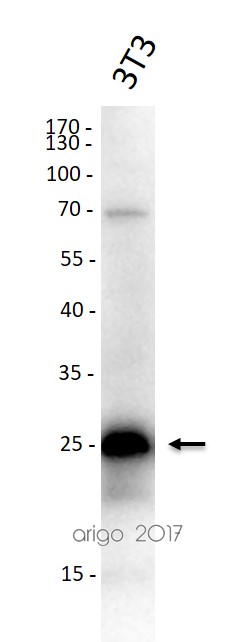ARG55102
anti-p27 Kip1 antibody
anti-p27 Kip1 antibody for Western blot and Mouse
Cancer antibody; Cell Biology and Cellular Response antibody; Gene Regulation antibody

1
概述
| 产品描述 | Mouse Monoclonal antibody recognizes p27 Kip1 |
|---|---|
| 反应物种 | Ms |
| 应用 | WB |
| 特异性 | This antibody detects endogenous levels of p27 Kip1 and does not cross-react with related proteins. |
| 宿主 | Mouse |
| 克隆 | Monoclonal |
| 同位型 | IgG1 |
| 靶点名称 | p27 Kip1 |
| 抗原物种 | Human |
| 抗原 | Purified recombinant Human p27 Kip1 protein fragments expressed in E.coli. |
| 偶联标记 | Un-conjugated |
| 別名 | Cyclin-dependent kinase inhibitor 1B; MEN4; KIP1; P27KIP1; Cyclin-dependent kinase inhibitor p27; p27Kip1; CDKN4; MEN1B |
应用说明
| 应用建议 |
|
||||
|---|---|---|---|---|---|
| 应用说明 | * The dilutions indicate recommended starting dilutions and the optimal dilutions or concentrations should be determined by the scientist. |
属性
| 纯化 | Affinity purification with immunogen. |
|---|---|
| 缓冲液 | PBS (pH 7.4), 0.03% Proclin 300 and 50% Glycerol |
| 抗菌剂 | 0.03% Proclin 300 |
| 稳定剂 | 50% Glycerol |
| 浓度 | 8.08 mg/ml |
| 存放说明 | For continuous use, store undiluted antibody at 2-8°C for up to a week. For long-term storage, aliquot and store at -20°C. Storage in frost free freezers is not recommended. Avoid repeated freeze/thaw cycles. Suggest spin the vial prior to opening. The antibody solution should be gently mixed before use. |
| 注意事项 | For laboratory research only, not for drug, diagnostic or other use. |
生物信息
| 数据库连接 |
Swiss-port # P46414 Mouse Cyclin-dependent kinase inhibitor 1B |
|---|---|
| 基因名称 | CDKN1B |
| 全名 | cyclin-dependent kinase inhibitor 1B (p27, Kip1) |
| 背景介绍 | This gene encodes a cyclin-dependent kinase inhibitor, which shares a limited similarity with CDK inhibitor CDKN1A/p21. The encoded protein binds to and prevents the activation of cyclin E-CDK2 or cyclin D-CDK4 complexes, and thus controls the cell cycle progression at G1. The degradation of this protein, which is triggered by its CDK dependent phosphorylation and subsequent ubiquitination by SCF complexes, is required for the cellular transition from quiescence to the proliferative state. Mutations in this gene are associated with multiple endocrine neoplasia type IV (MEN4). [provided by RefSeq, Apr 2014] |
| 生物功能 | Important regulator of cell cycle progression. Involved in G1 arrest. Potent inhibitor of cyclin E- and cyclin A-CDK2 complexes. Forms a complex with cyclin type D-CDK4 complexes and is involved in the assembly, stability, and modulation of CCND1-CDK4 complex activation. Acts either as an inhibitor or an activator of cyclin type D-CDK4 complexes depending on its phosphorylation state and/or stoichometry. [UniProt] |
| 细胞定位 | Nucleus. Cytoplasm. Endosome |
| 研究领域 | Cancer antibody; Cell Biology and Cellular Response antibody; Gene Regulation antibody |
| 预测分子量 | 22 kDa |
| 翻译后修饰 | Phosphorylated; phosphorylation occurs on serine, threonine and tyrosine residues. Phosphorylation on Ser-10 is the major site of phosphorylation in resting cells, takes place at the G(0)-G(1) phase and leads to protein stability. Phosphorylation on other sites is greatly enhanced by mitogens, growth factors, cMYC and in certain cancer cell lines. The phosphorylated form found in the cytoplasm is inactivate. Phosphorylation on Thr-198 is required for interaction with 14-3-3 proteins. Phosphorylation on Thr-187, by CDK1 and CDK2 leads to protein ubiquitination and proteasomal degradation. Tyrosine phosphorylation promotes this process. Phosphorylation by PKB/AKT1 can be suppressed by LY294002, an inhibitor of the catalytic subunit of PI3K. Phosphorylation on Tyr-88 and Tyr-89 has no effect on binding CDK2, but is required for binding CDK4. Dephosphorylated on tyrosine residues by G-CSF. Ubiquitinated; in the cytoplasm by the KPC complex (composed of RNF123/KPC1 and UBAC1/KPC2) and, in the nucleus, by SCF(SKP2). The latter requires prior phosphorylation on Thr-187. Ubiquitinated; by a TRIM21-containing SCF(SKP2)-like complex; leads to its degradation. Subject to degradation in the lysosome. Interaction with SNX6 promotes lysosomal degradation (By similarity). |
检测图片 (1) Click the Picture to Zoom In








